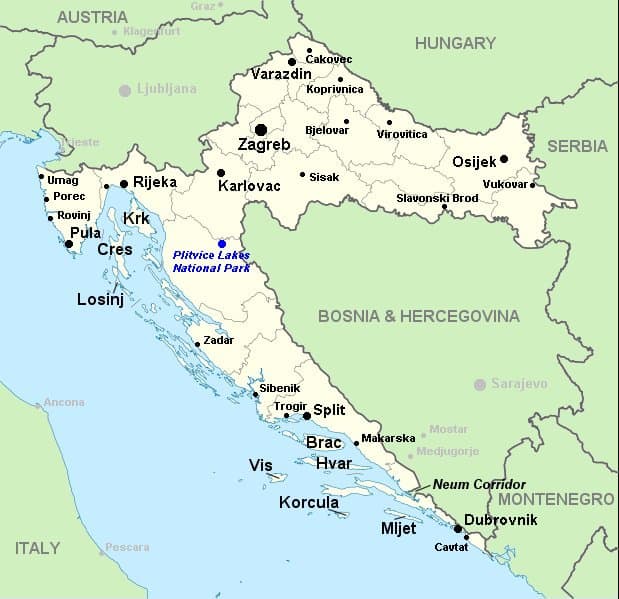To protect its airspace, Croatia must consider it's neighbours: Italy, Slovenia, Hungary, Serbia, Bosnia & Hercegovina and Montenegro.
Foreign Relations:
- The relations between Croatia and Italy have been largely cordial and friendly (although occasional incidents do arise on issues such as the Istrian exodus or the Ecological and Fisheries Protection Zone.) Both countries are full members of the European Union and NATO.
- Croatia and Slovenia have several land and maritime boundary disputes, mainly in the Gulf of Piran, regarding Slovenian access to international waters, a small number of pockets of land on the right-hand side of the river Dragonja, and around the Sveta Gera peak. Slovenia was disputing Croatia's claim to establish the Ecological and Fisheries Protection Zone, an economic section of the Adriatic. Both countries are full members of the European Union and NATO, however.
- The relations between Croatia and Hungary have been largely cordial and friendly. Both countries are full members of the European Union and NATO.
- The Danube border between Croatia and Serbia is in dispute, particularly in Baranja, the Island of Vukovar and the Island of Šarengrad. Croatia is full member of the European Union while Serbia is candidate for membership.
- The majority of the 'Yugoslav wars' were fought on Bosnia–Herzegovina territory. After the wars Bosnia and Herzegovina and Croatia retained the same border they had during SFR Yugoslavia. The two countries have several small disputed sections of the boundary (e.g. along the Una river) , the most prominent of which is the one related to maritime access(Neum, Pelješac peninsula). The ratification of the 1999 border agreement has not happened as of 2013. Both countries are full members of the Council of Europe
- Croatia and Montenegro have a largely latent border dispute over the Prevlaka peninsula. Croatia is full member of the European Union while Montenegro is candidate for membership. The accession of Montenegro to NATO has been in the negotiations stage as of 2010. A formal invitation was issued by the alliance on 2 December 2015, beginning the final accession talks which could be concluded by the Warsaw summit in July 2016.
Most likely conflict - if any would arise - would be with B&H, Serbia, and to a lesser extent Slovenia.
What do they all fly?
Italy: AMX International AMX, Panavia Tornado, Eurofighter Typhoon, and in future Lockheed -MartinF-35
Slovenia: Pilatus PC-9/M,
Hungary: JAS39 Gripen
Serbia: Orao, Super Galeb, Mig 21, Mig 29 (potentially still some Jastreb & Galeb)
Bosnia & Hercegovina: Jastreb, Orao, Galeb
Montenegro. Super Galeb
What does Croatia fly?
Croatia: Mig-21, PC-9
Croatia need a fighter good enough to counter Serbia's Mig 29s. Alternatives considered included Lockheed Martin's F-16, Saab's JAS-39 Gripen, France's Mirage 2000, Israeli Kfir and a version of South Korea's T-50. Leading contenders are Lockheed Martin's F-16 and Saab's JAS-39 Gripen. Personally, I think Kfir block 60 is not a bad option, it can certainly deal with Mig-21s (Serbia has only 4 Mig 29s left, probably in not too good a shape). But most likely it will be F-16 or Gripen. F-16 is most Nato compatible/furnishable, but Gripen is in service with e.g Hungary, Czech republic. Interestingly enough, both these Gripen user LEASE them (with an option to buy at the end of the lease), rather than buy, which is said to represent significant cost-savings. The NATO-compatible C/D 'Export Gripen' standard would be needed.
Slovakia is eager to lease eight to twelve SAAB JAS 39C/D Gripen aircraft for the coming 10 to 15 years.
Slovakia “wants Gripen” from 2016 | AIRheadsFLY.com
The amount mentioned above is similar to the amount the Czech payed. The lease was for 12-14 aircraft for an agreed period of 10 years at a cost of €780 million.
For Croatia, it has to be fully nato compatible.
It was offered to Bulgaria. Here is what Janes said about that:
Bulgaria to be offered JF-17 fighter by Pakistan | IHS Jane's 360
Re-engine? Interesting!
Klimov RD-33
- Length: 4,229 mm (166.50 in)
- Diameter: 1,040 mm (40.94 in)
- Dry weight: 1,055 kg (2,326 lb)
- Maximum thrust: 50.0 kN (11,230 lbf) Dry, 81.3 kN (18,285 lbf) Afterburning.
Guizhou WS-13
- Length: 4.14 metres (13.6 ft)
- Diameter: 1.02 metres (3 ft 4 in)
- Dry weight: 1,135 kilograms (2,502 lb)
- Maximum thrust: 51.2 kilonewtons (11,500 lbf) dry; 86.37 kilonewtons (19,420 lbf) with afterburner
Eurojet EJ200
- Length: 4 m (160 in)
- Diameter: 700 mm (28 in)
- Dry weight: 990 kg (2,180 lb)
- Maximum thrust: 60 kN (13,000 lbf) dry thrust; 90 kN (20,000 lbf) with reheat
I don't think the issue is not so much radar or engine though, but rather communications, iff, datalinks (i.e. for the purpose of interoperability)





